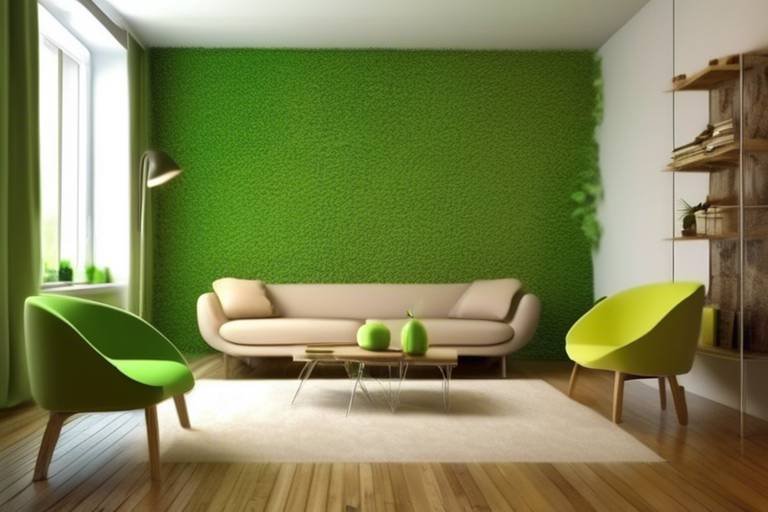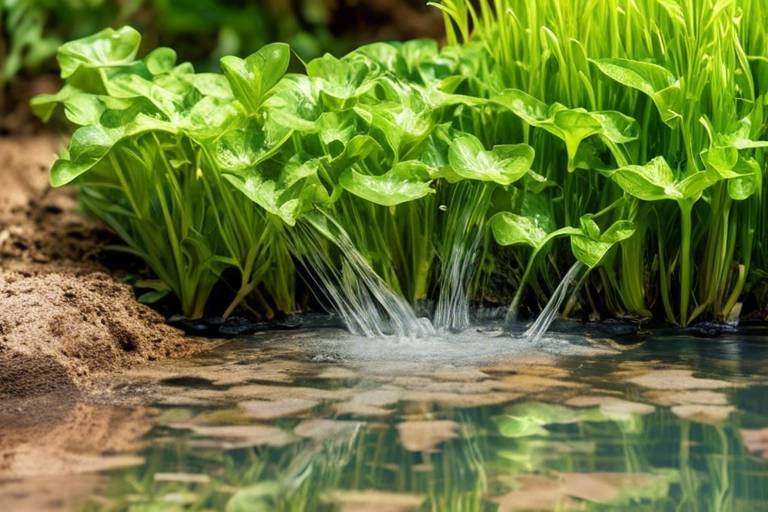10 Tips for Sustainable DIY Home Projects
Embarking on sustainable DIY home projects is not only a creative endeavor but also a way to contribute positively to the environment. By incorporating eco-friendly practices and materials, you can reduce your carbon footprint and create a greener living space for yourself and future generations to enjoy.
One of the fundamental principles of sustainable DIY projects is to reuse and upcycle materials. Instead of discarding old furniture, pallets, or glass jars, consider giving them a new life in your projects. Not only does this minimize waste, but it also adds a unique touch to your creations.
When it comes to lighting, choosing energy-efficient options is key. Opt for LED bulbs and solar-powered lights to lower your energy consumption and decrease electricity bills. Not only will this save you money in the long run, but it also aligns with your sustainability goals.
For painting projects, selecting low VOC paints is crucial. These paints have lower volatile organic compounds, which means they emit fewer harmful chemicals into the air. By improving indoor air quality, you can create a healthier living environment for you and your family.
Another essential aspect of sustainable home projects is installing water-saving fixtures. By incorporating water-efficient faucets, showerheads, and toilets, you can significantly reduce your water consumption. This not only conserves this precious resource but also promotes sustainability in your daily life.
When considering flooring options, opt for sustainable materials such as bamboo, cork, or reclaimed wood. These choices have a lower environmental impact compared to traditional flooring materials and can add a touch of natural beauty to your home design.
Integrating smart home technology into your projects can enhance energy efficiency. Smart thermostats, lighting controls, and energy monitoring systems allow you to optimize your energy usage and reduce waste. By leveraging technology, you can create a more sustainable and comfortable living space.
Setting up a home composting system is a great way to reduce organic waste and produce nutrient-rich soil for gardening. By diverting food scraps and other organic materials from landfills, you can contribute to a more sustainable waste management system.
Upgrading to energy-efficient appliances is a significant step towards sustainability. Energy-star rated appliances consume less energy, leading to lower utility costs and reduced environmental impact. By investing in these appliances, you are not only saving money but also helping the planet.
By following these , you can make a positive impact on the environment while creating a beautiful and eco-friendly living space. Embrace sustainability in your DIY endeavors and be a part of the movement towards a greener future.

Reuse and Upcycle Materials
When embarking on sustainable DIY home projects, one of the most impactful practices you can adopt is reusing and upcycling materials. By repurposing items such as old furniture, pallets, and jars, you not only minimize waste but also breathe new life into existing materials, adding a unique touch to your projects. Imagine transforming a worn-out chair into a vibrant garden planter or converting glass jars into stylish storage containers. The possibilities are endless, and the satisfaction of giving new purpose to old items is truly rewarding.
Additionally, upcycling materials can infuse your home with character and charm, showcasing your creativity and commitment to sustainability. Rather than discarding items that may seem worn or outdated, consider how they can be transformed into something beautiful and functional. Not only does this approach reduce the need for new materials, but it also adds a personal touch to your home decor, making each piece a conversation starter.
Moreover, upcycling can be a budget-friendly way to enhance your living space, as it often requires minimal investment beyond your time and creativity. By exploring the potential of materials that others may overlook, you can create unique pieces that reflect your style and values. Whether you're refurbishing a vintage dresser or repurposing wooden crates into shelving units, upcycling allows you to express your individuality while reducing your environmental impact.

Choose Energy-Efficient Lighting
When embarking on sustainable DIY home projects, one crucial aspect to consider is the choice of lighting. Opting for energy-efficient lighting solutions not only reduces your environmental footprint but also helps in cutting down electricity expenses over time. LED bulbs are a popular choice for eco-conscious homeowners due to their energy efficiency and longevity. These bulbs consume significantly less energy compared to traditional incandescent bulbs, making them an ideal option for sustainable lighting in your home.
Another eco-friendly lighting option to consider is solar-powered lights. These lights harness the power of the sun to illuminate your home's interior and exterior spaces. By utilizing solar energy, you can reduce your reliance on grid electricity, contributing to a greener lifestyle while enjoying cost savings on your energy bills. Solar lights are versatile and come in various designs, making them a stylish and sustainable choice for your DIY home improvement projects.
When selecting lighting fixtures for your sustainable home projects, it's essential to prioritize products that have earned the Energy Star certification. Energy Star-rated lighting fixtures meet stringent energy efficiency guidelines set by the Environmental Protection Agency (EPA), ensuring that they consume less power without compromising on performance. By choosing Energy Star-certified lighting options, you can enhance the sustainability of your home while benefiting from long-term energy savings.
In addition to choosing energy-efficient bulbs and fixtures, you can further optimize your lighting setup by incorporating smart lighting controls. Smart lighting systems allow you to adjust brightness levels, set schedules, and even control lights remotely using your smartphone or voice commands. By intelligently managing your lighting usage, you can minimize energy waste and create a more sustainable living environment for yourself and your family.

Use Low VOC Paints
When embarking on your sustainable DIY home projects, one crucial aspect to consider is the use of Low VOC paints. VOC stands for Volatile Organic Compounds, which are chemicals that can easily vaporize into the air, posing potential health risks and contributing to air pollution. By opting for paints with low VOC levels, you are not only safeguarding your health but also promoting environmental sustainability.
Low VOC paints are formulated to release significantly fewer harmful emissions compared to traditional paints, making them a safer and eco-friendly choice for your home improvement endeavors. These paints are available in a wide range of colors and finishes, ensuring that you can achieve the desired aesthetic appeal without compromising on sustainability.
Additionally, low VOC paints contribute to better indoor air quality, creating a healthier living environment for you and your family. With reduced exposure to toxic fumes, you can enjoy a fresh coat of paint in your home without worrying about harmful chemicals lingering in the air.
Moreover, using low VOC paints aligns with the principles of sustainable living by minimizing the environmental impact of your DIY projects. By choosing eco-conscious paint options, you are taking a proactive step towards reducing air pollution and promoting a greener future for generations to come.
When shopping for low VOC paints, look for certifications such as Green Seal or Greenguard to ensure that you are selecting products that meet stringent environmental standards. These certifications indicate that the paints have undergone testing to verify their low VOC content and adherence to sustainability criteria.

Install Water-Saving Fixtures
Exploring eco-friendly practices and materials for sustainable do-it-yourself home improvement projects to reduce environmental impact and promote a greener living space.
When embarking on sustainable DIY home projects, one crucial aspect to consider is the installation of water-saving fixtures. By incorporating water-efficient faucets, showerheads, and toilets, you can significantly contribute to water conservation efforts while promoting sustainability within your home renovations. These fixtures are designed to minimize water wastage without compromising on performance, allowing you to enjoy a greener lifestyle without sacrificing comfort.

Opt for Sustainable Flooring
Exploring eco-friendly practices and materials for sustainable do-it-yourself home improvement projects to reduce environmental impact and promote a greener living space.
When it comes to sustainable DIY home projects, one of the key considerations is the choice of flooring. Opting for sustainable flooring options not only enhances the aesthetic appeal of your home but also contributes to a more eco-friendly living environment. Sustainable flooring materials like bamboo, cork, or reclaimed wood are not only stylish but also help reduce the overall environmental impact of your home renovation projects.
By choosing bamboo flooring, you are selecting a renewable resource that grows rapidly and can be harvested without causing long-term damage to the environment. Cork flooring, made from the bark of cork oak trees, is another excellent sustainable option as it is biodegradable and provides natural insulation. Additionally, reclaimed wood flooring gives a second life to wood that would otherwise end up in landfills, adding a unique touch to your home while reducing waste.
Opting for sustainable flooring is a great way to make a positive impact on the environment while creating a beautiful and eco-friendly living space. These materials not only add character to your home but also contribute to a more sustainable future for generations to come.
Q: How can I ensure that the sustainable flooring I choose is truly eco-friendly?
A: When selecting sustainable flooring, look for certifications such as Forest Stewardship Council (FSC) or FloorScore, which indicate that the materials meet specific environmental and health standards.
Q: Are sustainable flooring options more expensive than traditional materials?
A: While some sustainable flooring options may have a higher upfront cost, they often prove to be more cost-effective in the long run due to their durability and eco-friendly nature.
Q: Can I install sustainable flooring myself as part of a DIY project?
A: Yes, many sustainable flooring options are designed for easy installation, making them suitable for DIY enthusiasts looking to create a more environmentally conscious home.

Implement Smart Home Technology
Implementing smart home technology is a game-changer in sustainable DIY projects. By integrating smart thermostats, you can efficiently regulate your home's temperature, reducing energy waste and cutting down on utility costs. Additionally, lighting controls allow you to manage your home's lighting remotely, ensuring lights are only on when needed, further saving energy.
Moreover, energy monitoring systems provide real-time data on your energy consumption, empowering you to make informed decisions to enhance energy efficiency. Imagine having the ability to track and optimize your energy usage, leading to a more sustainable and cost-effective home environment.

Create a Home Composting System
Creating a home composting system is a fantastic way to reduce waste, enrich your garden soil, and contribute to a more sustainable lifestyle. Instead of tossing organic scraps into the trash, you can transform them into nutrient-rich compost that benefits your plants and the environment.
Start by designating a composting area in your backyard or even indoors if space is limited. You can use a compost bin or simply create a compost pile in a corner of your yard. Consider the size of your household and the amount of waste generated to determine the right composting setup for you.
When setting up your composting system, remember to balance the ratio of green (nitrogen-rich) and brown (carbon-rich) materials. Green materials include fruit and vegetable scraps, coffee grounds, and grass clippings, while brown materials consist of dry leaves, straw, and shredded paper. Layering these materials correctly will help speed up the composting process and prevent odors.
It's essential to regularly turn and aerate your compost pile to ensure proper decomposition. This process introduces oxygen, which is crucial for the growth of beneficial microorganisms that break down the organic matter. Mixing the compost also helps distribute moisture evenly and prevents the formation of compacted layers.
Monitor the moisture levels of your compost pile to keep it damp but not waterlogged. If the compost becomes too dry, add water to maintain the ideal conditions for decomposition. Conversely, if it's too wet, incorporate more dry materials to improve airflow and prevent unpleasant odors.
As your compost matures, you'll notice the transformation of the materials into dark, crumbly compost ready for use in your garden. This nutrient-rich compost can be added to your soil to improve its structure, fertility, and water retention capacity, leading to healthier plants and reduced reliance on chemical fertilizers.
By creating a home composting system, you not only reduce your ecological footprint but also actively participate in the natural cycle of decomposition and regeneration. It's a simple yet impactful way to embrace sustainability and cultivate a greener future for yourself and the planet.

Invest in Energy-Efficient Appliances
When embarking on sustainable DIY home projects, one crucial aspect to consider is investing in energy-efficient appliances. These appliances are designed to consume less energy while maintaining optimal performance, making them an excellent choice for reducing utility costs and promoting environmental sustainability.
Energy-efficient appliances come with the Energy Star rating, indicating that they meet specific energy efficiency guidelines set by the Environmental Protection Agency. By upgrading to these appliances, you not only contribute to a greener environment but also enjoy long-term savings on your energy bills.
These appliances are equipped with advanced technologies that optimize energy usage without compromising on functionality. From refrigerators and washing machines to dishwashers and air conditioners, there are energy-efficient options available for various household needs.
Moreover, energy-efficient appliances often come with additional features such as programmable settings, eco-friendly modes, and energy usage monitoring, allowing you to have better control over your energy consumption and make informed decisions to reduce your carbon footprint.
By making the switch to energy-efficient appliances in your DIY home improvement projects, you not only contribute to a more sustainable future but also enjoy the benefits of lower energy bills, increased home value, and a more eco-friendly lifestyle.
Frequently Asked Questions
- What are the benefits of choosing sustainable materials for DIY home projects?
Opting for sustainable materials helps reduce environmental impact by conserving resources, lowering energy consumption, and promoting a healthier living environment. It also allows you to contribute to a greener future while creating a unique and stylish home design.
- How can I incorporate smart home technology into my DIY projects?
You can integrate smart thermostats, lighting controls, and energy monitoring systems to enhance energy efficiency and sustainability in your home projects. These technologies enable you to monitor and control energy usage, leading to cost savings and environmental benefits.
- Why is it important to use low VOC paints in DIY home renovations?
Low VOC paints help improve indoor air quality by minimizing harmful emissions that can be detrimental to health. By choosing low VOC options, you create a safer and more comfortable living space for you and your family while reducing your environmental footprint.



















